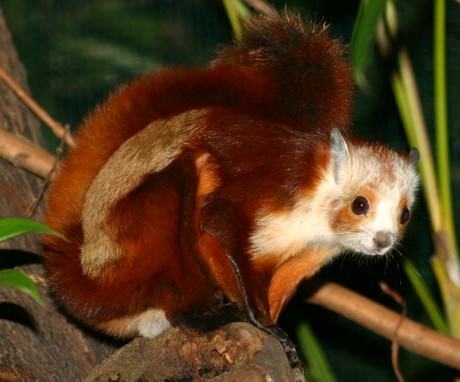
Red giant flying squirrel, or Common giant flying squirrel (Petaurista petaurista)
Phylum — chordata
Class — mammalia
Order — rodentia
Family — sciuridae
Genus – petaurista
Appearance
The Giant flying squirrel has a distinctive, thickly haired flying membrane that extends from its wrists to its hind legs and is further expanded by a skin fold between the tail root and the hind legs. This membrane is composed of sheets of muscles that can be tensed or relaxed at will, thus controlling the direction of glide. In addition, there is a large spur on the edge of this membrane that helps to support it. Petaurista petaurista is characterized by its large eyes and mahogany-red coloring, though coloration varies with environment.
Relative to other squirrels, this species is very large; its head and body length average 398mm and its tail adds an additional 422mm. Five digits, all of which have curved and sharp claws, are found on the hind feet and four are found on the forefeet.
Habitat
Red giant flying squirrels are found in northern South Asia, East Asia and Southeast Asia. Their range extends from Afghanistan, into northern India and Pakistan through to Java, and Taiwan, and also Sri Lanka. They can also be found in parts of Borneo and were recorded in Peninsular Malaysia, including Penang, Tioman Island and also Singapore.
Behavior
Red giant flying squirrels are solitary and arboreal. They are good climbers and can glide for long distances up to 75 meters (250 ft.) or greater. They live in nest holes which are usually located at least 10m above ground. Red giant flying squirrels do not hibernate but may migrate to areas with more food. They are also able to explore conifer plantations and use them as feeding and resting areas. These flying squirrels are nocturnal being most active between sunset and midnight. They usually become vocal during the evening hours and their low, monotonous moan is believed to be a mating call.
Diet
Red giant flying squirrels are herbivorous animals. They feed primarily on conifer cones, leaves and branches, and, when in season, fruits and nuts, and occasionally insects.
Reproduction
Little is known about the mating system and reproductive behavior of Red giant flying squirrels. They usually breed once a year. Females give birth to 1 or 2 kittens in February and August. Young are nursed in a nest made by the mother until 2.5 months of age.
In captivity
The lifespan of these squirrels can be up to 16 years in captivity.
To keep the Red giant flying squirrels, you need an aviary with vertical tree trunks installed in it and large boxes-houses made of plywood. All day long, Red giant flying squirrels spend in houses, because in nature, these animals are nocturnal.
Red giant flying squirrels are fed with raisins and nuts, but do not forget about branch and leafy food.
 Russian
Russian
 English
English
























